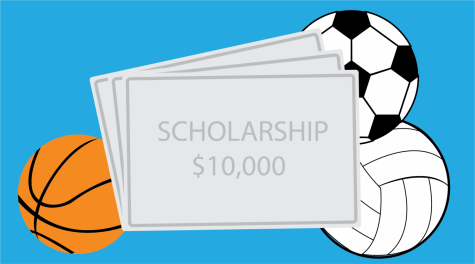Filling the rosters with driven athletes
Stava, Simonson, talk scholarship process in the athletic department
May 19, 2021

As athletic seasons begin and end, at least one thing remains consistent: Coaches must fill empty spots on their roster with new players, and they do so by looking at high school talent, or athletes that may want to transfer to a different college. To help reward and draw competitors into continuing the process of playing sports, like with many other activities, a certain amount of each coach’s budget goes into drawing in athletes who will excel in sports, school and in life.
“It is the responsibility of our coaching staff to use that money to fill their team with the most talented, academically and athletically prepared students,” said athletic director Jackson Stava. “There are certainly different ways that all of our coaches look to do that, but that scholarship money is used so that we can attract a very high-level student and a very high-level athlete to make sure that we have the most competitive team.”
Athletics are not the only factor determining whether a student-athlete receives a scholarship. The passion as a student is crucially essential in developing into a potential college athlete.
“We really try to target student-athletes that are great students first because that goes a long way as we get to stacking scholarships,” said women’s basketball head coach Mike Simonson.
“If we know that they are good students already in high school or in junior college or as a transfer student, we know that they’re going to do pretty well just in the culture and how we do things at SPU.”
Athletic Scholarships are awarded to athletes on a year to year basis because coaches are not permitted to give out a scholarship for more than one academic year at a time. However, a similar amount of money is usually given to an athlete each year. The annual concept also helps make sure there is a balanced amount of experience on the team.
“Our students are not necessarily tied to the same amount they got as an incoming freshman or transfer. There are actually quite a bit of NCAA and conference regulations that guide the way that we give about those scholarships,” said Stava “We are not allowed by NCAA rules to offer multiple year scholarships.
“If four seniors graduate, you want to make sure that four freshmen are coming in,” said Simonson. “It is really important that you balance your roster out properly with the number of scholarship dollars.”
While walk-on athletes do not start with an athletic scholarship, that does not have to remain the same during their athletic career. Coaches can decide to reward an athlete with a scholarship at any point in the athlete’s career.
“There have been many instances where athletes started off as a walk-on, on the team. We have had some instances where a student would stay as a walk on for their entirety of their career at SPU,” said Stava. “We have also had examples where an athlete started as a walk on and earned scholarship money through their dedication, leadership, athletics, etc, over the course of the time that they’re at SPU.”
Injuries are of high significance in the athlete’s career. Some injuries are minor, while others can be major setbacks.
“Each situation is different. A career-ending injury as a junior may result in a different outcome than someone getting hurt skateboarding as a freshman. There is no roadmap when it comes to
an injury whether it’s on the field or off the field,” said Stava. “The medical advances are great that career-ending injuries are much fewer and far between than they used to be.”
Despite each sport having its own rules and distributing athletic scholarships differently, they all share the same objective of motivating athletes to perform well academically and earn their desired degrees.
“We have to hope for the best and expect the worst because you have to prepare for not being able to get everything that you would want or aspire to achieve from every goal that you might have,” said Simonson.

























































































